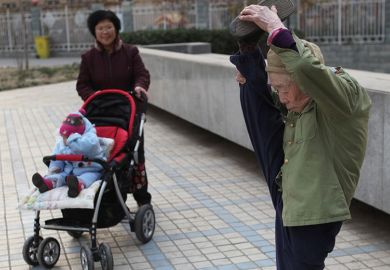Ruth Silin particularly likes the poetry courses she takes at Lasell College, a small university near Boston where she lives on the campus. When she is not in class, she keeps busy with extracurricular activities, most recently producing and modelling in a student fashion show.
But Ms Silin differs from her classmates in one important way: she is 95 years old, and among a small but growing number of affluent retirees being invited to live on or near US university campuses and avail themselves of the educational opportunities and facilities.
“I loved the fact that it was on a college campus and associated with a college,” Ms Silin said. “It’s a wonderfully stimulating thing. When you reach this age, you don’t want to just be surrounded by other grey-haired people.”
For the universities, which are often property rich, these older students can contribute more than just diversity: they can be a source of badly needed revenue and, potentially, generous bequests.
Ms Silin, for example, is among 220 retirees who live at Lasell Village, which is part of a small college with an enrolment of about 1,700 that manages the development and receives lease payments. The senior students pay an entry fee of between $440,000 (£341,000) and $1.4 million, depending on apartment size, plus monthly fees of between $4,000 and $9,500.
Other such communities are privately operated but lease land from institutions including Stanford University, whose faculty are paid to teach classes to residents. One at Duke University provides a licence fee to use the university’s name.
Enrolment of traditional-aged undergraduates in the US is down by 7 per cent since 2011, according to the Department of Education, while the number of older people – baby boomers who want to stay active in retirement – is soaring.
They comprise “a population to court both for potential degree-seeking students as well as for relationships to support the bottom line”, said Tom Meuser, director of the Center for Excellence in Aging and Health at the University of New England, who studies older learners.
“Competition is high for students of any age,” said Professor Meuser, whose own university has teamed up with a new housing complex for people aged 55 and over that is being opened in a former convent where, among other things, his centre will conduct research. “So schools are casting wider nets.”
Arizona State University plans a 20-storey residential building on its campus for people in their sixties and older, who will be able to take classes and also mentor younger students, guest-lecture, work as guides in the art museum and ushers in the performance hall, and even provide childcare for faculty. The site, ASU Mirabella, will not open until next year, but it has already sold 217 of its 252 apartments at an entry fee of up to $774,000 plus monthly payments ranging from $4,195 to $5,570.
Although the public university is reportedly getting an upfront payment of $7 million from the private company that is building the $270 million development, it “isn’t in this for the money. Other projects could have yielded much more money than that,” said Todd Hardy, managing director of innovation zones at ASU.
“What we’re interested in is every way that people can learn, regardless of their age,” said Mr Hardy. “Folks who are of this age today want to be contributing members of a community and give back and continue learning. We want to integrate what they can offer with the life of our community, so we can both learn from each other.”
Many of these older students are alumni. A quarter of the residents at Vi at Palo Alto, near Stanford, for example, are alumni of that university or former faculty or staff.
Universities could benefit from this institutional loyalty over the long term, said Mr Hardy; with 80 per cent to 90 per cent of those entry fees refunded when they die, some may choose to leave the money to their alma maters.
“There could be an element of building relationships” that could lead to financial support, he said.
It would, however, be cynical to think that that is the only motivation, he said.
“Some universities do this as a real estate deal,” he said. “I don’t think there’s anybody that’s done it for the reason we are, which is to make these folks part of our lives and vice versa.”
In fact, said Professor Meuser, if they are exclusively transactional, such efforts will founder.
“If you’re just going at it for the money, without providing the coordination or the exchange or the ways to engage, it’s just not going to happen,” he said. “It’s a whole package, and ultimately these relationships thrive when there are strong benefits for the institution, the students, the faculty and the older adults.”
As she speaks about her experience at Lasell, Ms Silin has just returned from an activity at which art students interpreted poetry written by her and some of her neighbours. In addition to taking classes, they can use the library, the shuttle bus and the gym, and they spend still more time with the younger students who make extra money working in their dining room.
“We don’t see our own grandchildren as much as we see the kids on campus,” Ms Silin enthused. “This is a great way to spend your final years.”
POSTSCRIPT:
Print headline: ‘It’s a wonderfully stimulating thing’
Register to continue
Why register?
- Registration is free and only takes a moment
- Once registered, you can read 3 articles a month
- Sign up for our newsletter
Subscribe
Or subscribe for unlimited access to:
- Unlimited access to news, views, insights & reviews
- Digital editions
- Digital access to THE’s university and college rankings analysis
Already registered or a current subscriber?










